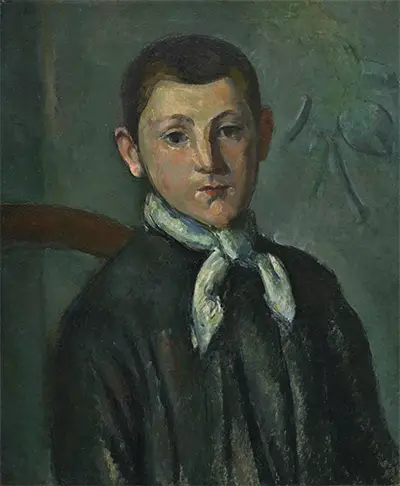 Buy Art Prints Now
Buy Art Prints Nowfrom Amazon
* As an Amazon Associate, and partner with Google Adsense and Ezoic, I earn from qualifying purchases.
The Portrait of Louis Guillaume was completed between the years 1879 and 1890 by French artist Paul Cezanne. The mediums used for this painting are oil on canvas. The dimensions of this painting are 55.9 x 46.7 cm (22 x 18 3/8 in).
Louis Guillaume was the son of Cezanne's friends and a friend of his son Paul. The painting is currently located in the National Gallery of Art in Washington, D.C. In this portrait, the colours used are greys, whites, and dark greens. These colours match the tone of the painting. It is difficult to tell what he is feeling and everything in the painting adds to that uncertainty of not knowing what might be going on in his mind. The lightest tone in the painting is the white scarf worn around the neck.
While the Portrait of Louis Guillaume is that of a real person, the manner in which it is painted is not realism. There are shadow and light which gives some depth, but the shapes on the face are basic. There are no details that would make the boy stand out, no distinguishing features that one would see in real life. In spite of these features, the detail on the wall softens the near harsh look of the painting. The ornament near the boy's head on the right looks like it might be a flower or plant of some kind, but it's not clear. Also, the painting is not totally lifeless, there is some reddish, pinkish colour on the cheeks and forehead.
Even though there are some abstract elements to the Portrait of Louis Guillaume, the folds in his clothes suggest some realism. So Cezanne is still reserved somewhat in terms of how far he went with his experimentation. His take on abstraction, in this case, is the basic shape of the head and body. There is no movement and everything appears to be lifeless which, in addition to the colours, adds to the sombre look of the painting.
This painting has changed hands several times. Ambroise Vollard, a French Art dealer, purchased the painting by 1906. He provided support to Cezanne and other contemporary artists when they were unknown. It was then sold around 1907 to a Florentine collector and then to Chester Dale, an American banker and patron of the arts, in 1927. A donation was made by Dale to the National Gallery of Art in 1963.




